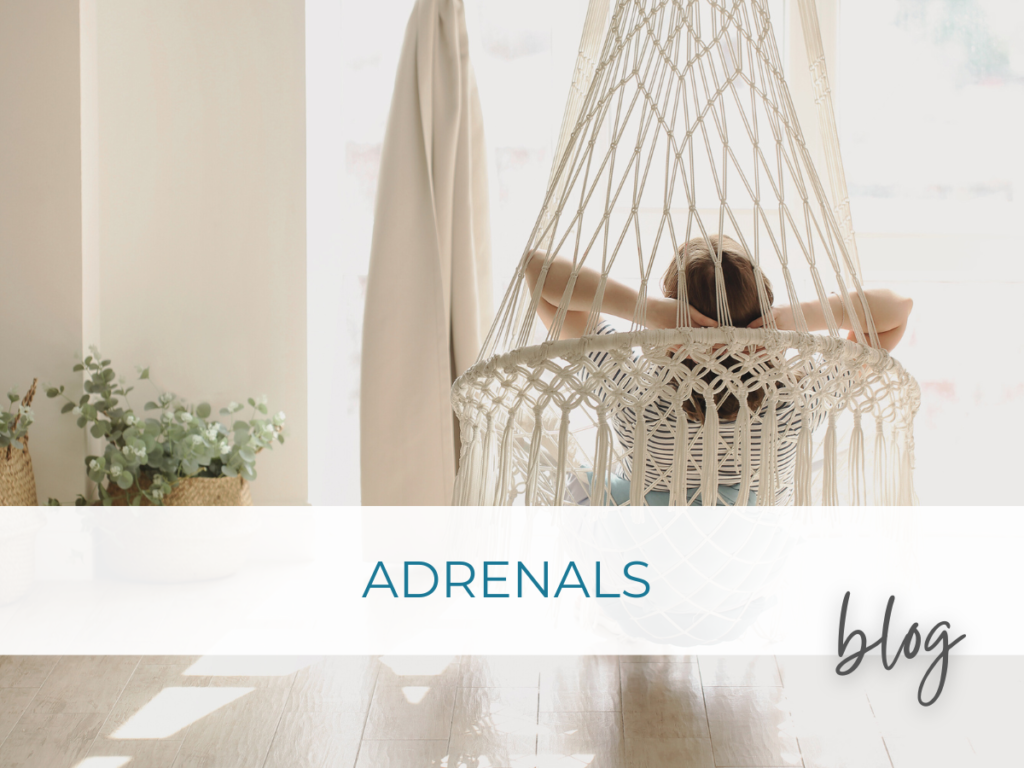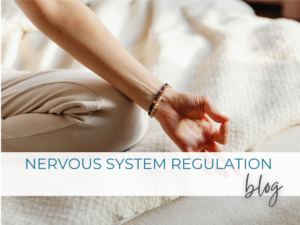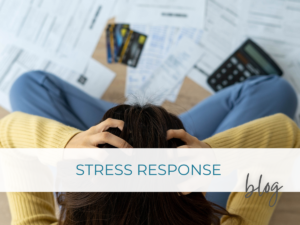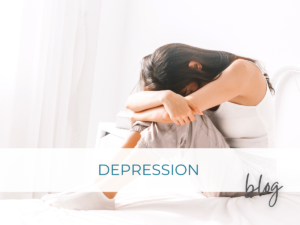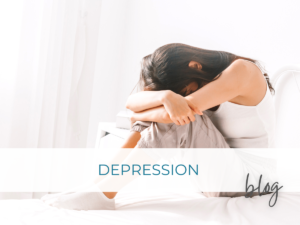Stress is bad for us. I think I might say this every day! What I mean by this is a stress response, including chronic high stress hormones, can have impacts on the nervous system, immune function, hormonal balance, sleep, mood and metabolic health. Too much stress for too long, eventually leads to burnout.
The HPA Axis
The hypothalamic-pituitary-adrenal (HPA) axis is composed of the hypothalamus and the pituitary gland, located in the base of the brain and the adrenal glands, located just above the kidneys. This axis plays a crucial role in the body’s response to stress
The Hypothalamus is our Stress On/Off Switch
Our bodies are designed to withstand stress in short bursts. Imagine a caveperson, leaving the cave for an hour at a time, to hunt or gather food and with the need to avoid predators. When the stress begins, leaving the cave, the imaginary switch in the hypothalamus turns on, stimulating the pituitary gland to secrete ACTH, which tells the adrenal glands to produce cortisol. The impact of the stress response is to make us more alert, and to keep us safe as we venture out into danger. When it is time to return to the safety of the cave, the again imaginary switch in the hypothalamus turns off, shutting off the ACTH secretion and the stress response.
Now contrast this to our modern world. We might start our day with a blaring alarm clock, start worrying about our day as we wake, spend an hour in traffic each way to work, work for 8 hours, with lunch at our desk, get home in time to drive kids to activities, only to fall asleep on the couch after watching an adrenaline-promoting zombie apocalypse show. I exaggerate for dramatic effect, but am I that far off? There is not a moment in the day of rest or breaks for the stress switch to turn off. In fact, with chronic stress, the hypothalamus can become inflamed, and the switch can get stuck in the on position.
The first step to helping our HPA axis, might be then, to carve out breaks in our day, when we truly step away from our stressors, and actively turn our stress response off.
The Vicious Stress Cycle
Stress begets more stress. When we have stress for prolonged periods of time, our body dials up our cortisol output. Excess cortisol over time will lower our tolerance to stress, meaning we just won’t handle it as well, leading to more cortisol output. Cortisol is our long burning stress hormone.
Symptoms of High Cortisol
Cortisol has numerous adverse effects in the body including:
- Insomnia especially waking between 2-4 am with an active or anxious brain
- Increased anxiety and ruminating
- Irritability – things that would not normally bother us, are ticking us off
- Increased Abdominal Body Fat and Muscle and Bone Loss
- Frequent Colds and Infections
- Inflammation and Metabolic Dysfunction
Perceived vs. Actual Stress
I will often ask, is it me or is it the stressor?
The stressor, which is a term I prefer over my stress, is the SITUATION, and by calling it a stressor, I emphasize in my own brain that this is something outside of myself, and possibly beyond my control. If the stressor is something stressful, we are meant to feel stressed, and our bodies are designed to secrete stress hormones in response to the stressor, to help us face it.
The question, “is it me?”, refers to my stress response. It is important to recognize if our stress response is proportional to the stressor or not. If we find ourselves overreacting to stressors, especially if these are things that wouldn’t normally bother us, it is a sign that our stress response is out of balance. I developed a test to determine whether or not my adrenals are healthy, and I call it the honk test. The honk test refers to how my body responds when someone honks at me while driving. If I jump, get a racing heart, get angry or upset, and especially if I’m still thinking about it later, it is a sign that my adrenals need some support. When my adrenals are balanced, I have found myself thinking, “Oh well, that person is really upset with me, they must be having a bad day. I hope they’re ok.” Such a difference!
Cortisol and the Circadian Rhythm
Our cortisol curve is synonymous with our circadian rhythm. Cortisol and Melatonin are the two main hormones that govern our sleep-wake cycle. Our cortisol doubles within the first hour of waking, and slowly tapers as the day goes on. Melatonin starts to rise around 8pm and then persists throughout our sleep.
Testing our Cortisol Curve
Our cortisol curve can be tested through urine or saliva and Naturopathic Doctors will often run a 4-point cortisol, meaning we measure at 4 times during the day, to plot a cortisol curve.
Lifestyle Interventions to Balance the Circadian Rhythm
There are many things that we can implement, starting right now to help balance our adrenal glands. Our adrenals LOVE routine!
- Wake up at the same time every morning
- Get sunlight exposure on our eyes, outside and without sunglasses within 5 minutes of waking. In the depths of winter? Use a sunlight lamp or turn all the lights on first thing in the morning.
- Get exercise earlier in the day, and avoid vigorous exercise in the evening as it could raise night-time cortisol
- Go to bed by 10pm. The benefits of the sleep before midnight, are two-fold.
- Wind down in the evening with darker lighting and calm activities and avoid screens.
- Sleep in total darkness as light interrupts melatonin secretion.
Stages of Adrenal Fatigue
Alarm – in the early phases of stress, the response is elevated cortisol throughout the entire day. Symptoms may include increased anxiety, irritability and insomnia.
Resistance – as the stress persists, we sometimes see a “wired but tired” patten where the cortisol curve can actually reverse, low during the day, leading to fatigue and elevated at night, leading to a “second wind” and active brain when we are supposed to be winding down for sleep.
Exhaustion – the final phase of adrenal fatigue happens after prolonged stress or sometimes it is the crash that happens right after the stress is over. The cortisol curve is now low and flat and symptoms are extreme fatigue. Patients will report that even a cup of coffee doesn’t give them any energy at this point. This is burnout – too much stress, for too long, without any support for the adrenals.
Adrenal Support
Supporting the Adrenals is foundational in Naturopathic Medicine. In addition to lifestyle interventions, we use nutrition, adaptogenic herbs, vitamins, injections and IV therapy to restore healthy adrenals, to better equip the body to handle stress as it comes.


